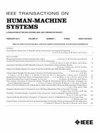Estimating Perceived Mental Workload From Eye-Tracking Data Based on Benign Anisocoria
IF 4.4
3区 计算机科学
Q2 COMPUTER SCIENCE, ARTIFICIAL INTELLIGENCE
引用次数: 0
Abstract
From the initial phases of human–computer interaction, where the computer was unaware of the users' mental states, we are now progressing toward cognition-aware user interfaces. One crucial cognitive state considered by research on cognition-aware user interfaces is the cognitive load. Eye-tracking has been suggested as one particularly unobtrusive method for estimating cognitive load. Although the accuracy of cognitive load detection has improved in recent work, it is still insufficient for cognition-aware user interfaces, which require high accuracy for getting accepted by the user. This article introduces two new eye-tracking metrics for estimating perceived cognitive load based on benign anisocoria (BA). Unlike previous pupil-based metrics, our metrics are based on pupil size asymmetry between the left and right eye. As a case study, we illustrate the effectiveness of the proposed metrics on a recently published eye-tracking dataset recorded under laboratory conditions. The results show that our proposed features based on BA can improve the performance of classifiers for detecting the perceived mental workload associated with an根据眼球跟踪数据估算良性眼球异位症患者的心理工作量
在人机交互的最初阶段,计算机对用户的心理状态一无所知,而现在,我们正朝着认知感知用户界面的方向迈进。认知感知用户界面研究考虑的一个关键认知状态是认知负荷。眼球跟踪被认为是估算认知负荷的一种特别不显眼的方法。虽然认知负荷检测的准确度在最近的研究中有所提高,但对于认知感知用户界面来说仍然不够,因为用户界面需要高准确度才能被用户接受。本文介绍了两种新的眼动跟踪指标,用于估计基于良性异视(BA)的感知认知负荷。与以往基于瞳孔的指标不同,我们的指标基于左右眼瞳孔大小的不对称。作为一项案例研究,我们在最近发布的实验室条件下记录的眼动数据集上说明了所提指标的有效性。结果表明,我们提出的基于 BA 的特征可以提高分类器在检测与 N$-back 测试相关的感知脑力劳动负荷时的性能。光梯度提升分类器的最佳分类准确率为 84.24%,而在没有使用所提出特征的情况下,分类准确率为 81.91%。
本文章由计算机程序翻译,如有差异,请以英文原文为准。
求助全文
约1分钟内获得全文
求助全文
来源期刊

IEEE Transactions on Human-Machine Systems
COMPUTER SCIENCE, ARTIFICIAL INTELLIGENCE-COMPUTER SCIENCE, CYBERNETICS
CiteScore
7.10
自引率
11.10%
发文量
136
期刊介绍:
The scope of the IEEE Transactions on Human-Machine Systems includes the fields of human machine systems. It covers human systems and human organizational interactions including cognitive ergonomics, system test and evaluation, and human information processing concerns in systems and organizations.
 求助内容:
求助内容: 应助结果提醒方式:
应助结果提醒方式:


